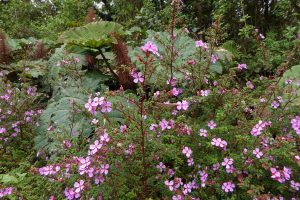In this series of posts, Carsten Brühl reports about his current trip to Costa Rica. Part 5 is all about air sampling in a cloud forest to detect persistent pesticides travelling to remote areas.
We went to the Tapanti National Park in the central mountains of the Cerro de la Muerte – a very pleasant trip, as I did not expect to be able to do field work in a cloud forest as an ecotoxicologist. Our purpose was to collect a long-term air sampler, which is part of an air monitoring program running for over 15 years already. The program was established as a global network of air measurement stations in collaboration with institutions from Canada. In the morning, Clemens and I got material to install the air sampler. Then we picked up Luisa Castillo who used to be in charge of the Regional Institute for Studies on Toxic Substances (IRET) for 30 years, and is recognised as a founder of ecotoxicological research in Central America. Luisa was involved in many research fields related to ecotoxicology and is still active as an advisor in authorities and research institutions despite her retirement.
After a 3-hour drive from the Valle Central we reached the mountain forest area and passed by a less visited ranger station of the Tapanti Park to go uphill through an oak forest on a dirt track. Finally we reached the research site on around 2,900 m elevation. The air sampler was almost damaged by a tree fall, possibly caused by a hurricane in November. Thus, we decided to create a more solid construction. Clemens replaced the sampling material, a special foam, and installed the sampler back in place for the next collecting period.
The Costa Rican cloud forest is a special ecosystem, far away from the large-scale intensive agriculture of the lowlands where pineapple, banana and oil palm dominate. The trees of the misty cloud forest surrounding the air sampler site are covered by thick moss layers and bromeliads. Clouds are continuously drifting through. Why would an air sampler collect any pesticides in such a remote location?
Previous research by IRET and colleagues from Canada has shown that persistent pesticides are transported to the mountain areas of Costa Rica where they were collected in soil, water and plant material as well as in the mist. This large-scale transport mechanism of pesticides is also named the “grasshopper effect”. Pesticides used in the lowlands are not localised but are distributed over a large area into places where breakdown processes are very slow due to lower temperature and less UV radiation because of constant cloud cover.

Ground vegetation in the cloud forest, with Gunnera species producing large plants (photo by C. Brühl)
It should therefore be kept in mind that presumably many organisms and ecological processes in cloud forest ecosystems can be influenced by pesticides even in areas where applications never occurred in close proximity. The air monitoring program provides important information about pesticide transport processes and could also be used to identify risky compounds that travel to these areas.
We enjoyed a wonderful early dinner overlooking Quetzal Valley and studying many bird species that came to the feeding station of the restaurant before returning to the lab to store the samples and material.



